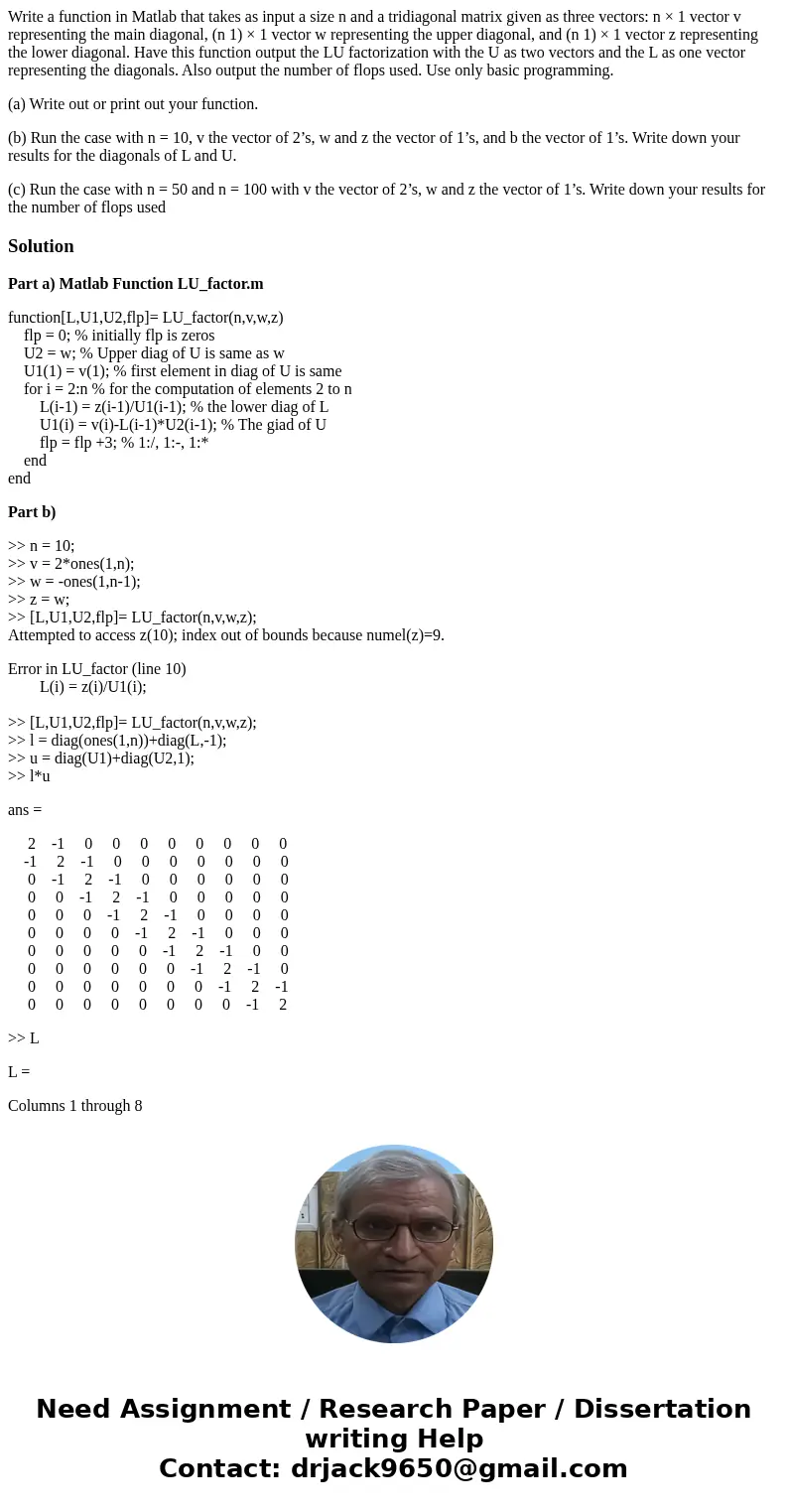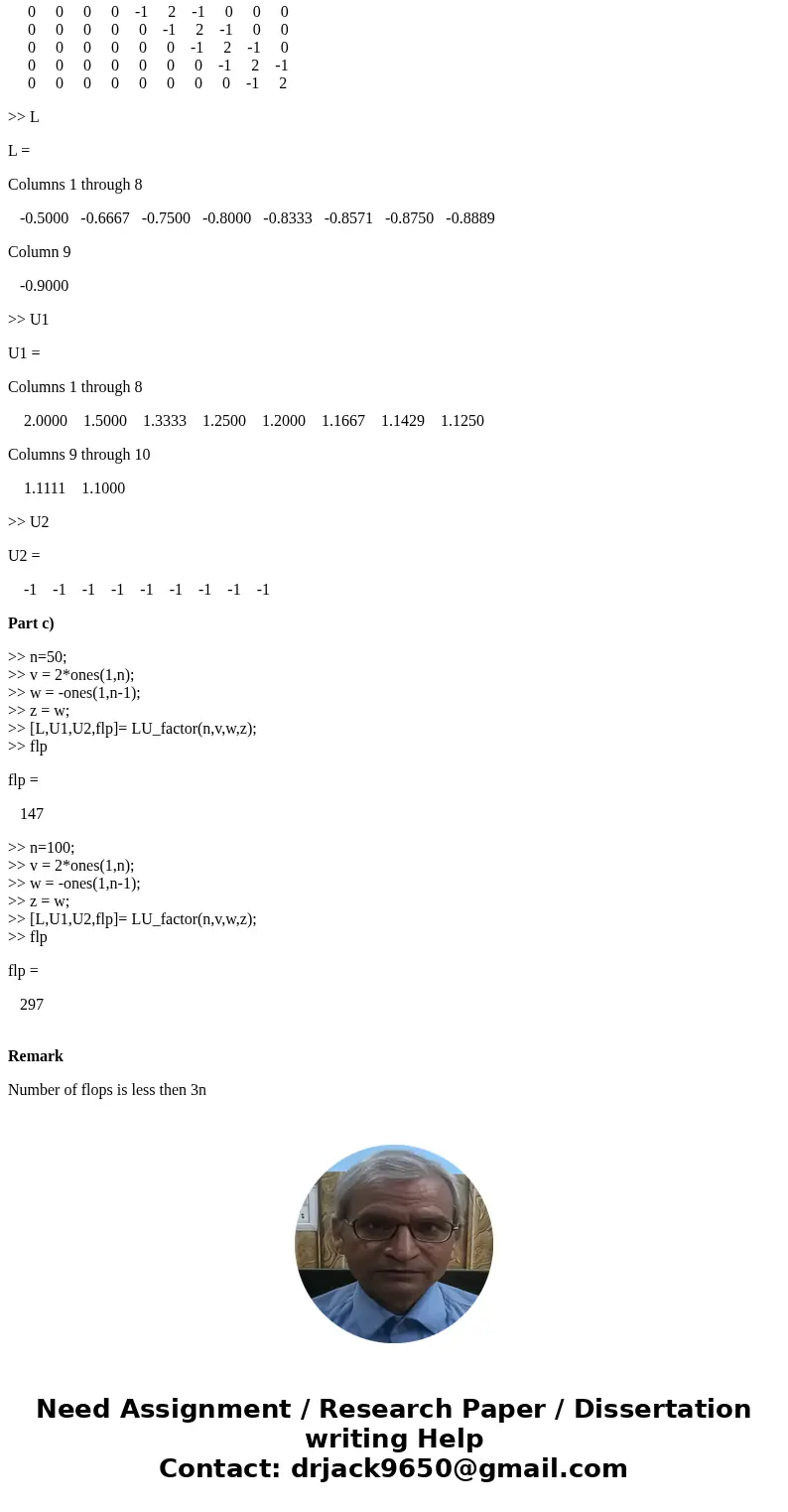Write a function in Matlab that takes as input a size n and
Write a function in Matlab that takes as input a size n and a tridiagonal matrix given as three vectors: n × 1 vector v representing the main diagonal, (n 1) × 1 vector w representing the upper diagonal, and (n 1) × 1 vector z representing the lower diagonal. Have this function output the LU factorization with the U as two vectors and the L as one vector representing the diagonals. Also output the number of flops used. Use only basic programming.
(a) Write out or print out your function.
(b) Run the case with n = 10, v the vector of 2’s, w and z the vector of 1’s, and b the vector of 1’s. Write down your results for the diagonals of L and U.
(c) Run the case with n = 50 and n = 100 with v the vector of 2’s, w and z the vector of 1’s. Write down your results for the number of flops used
Solution
Part a) Matlab Function LU_factor.m
function[L,U1,U2,flp]= LU_factor(n,v,w,z)
flp = 0; % initially flp is zeros
U2 = w; % Upper diag of U is same as w
U1(1) = v(1); % first element in diag of U is same
for i = 2:n % for the computation of elements 2 to n
L(i-1) = z(i-1)/U1(i-1); % the lower diag of L
U1(i) = v(i)-L(i-1)*U2(i-1); % The giad of U
flp = flp +3; % 1:/, 1:-, 1:*
end
end
Part b)
>> n = 10;
>> v = 2*ones(1,n);
>> w = -ones(1,n-1);
>> z = w;
>> [L,U1,U2,flp]= LU_factor(n,v,w,z);
Attempted to access z(10); index out of bounds because numel(z)=9.
Error in LU_factor (line 10)
L(i) = z(i)/U1(i);
>> [L,U1,U2,flp]= LU_factor(n,v,w,z);
>> l = diag(ones(1,n))+diag(L,-1);
>> u = diag(U1)+diag(U2,1);
>> l*u
ans =
2 -1 0 0 0 0 0 0 0 0
-1 2 -1 0 0 0 0 0 0 0
0 -1 2 -1 0 0 0 0 0 0
0 0 -1 2 -1 0 0 0 0 0
0 0 0 -1 2 -1 0 0 0 0
0 0 0 0 -1 2 -1 0 0 0
0 0 0 0 0 -1 2 -1 0 0
0 0 0 0 0 0 -1 2 -1 0
0 0 0 0 0 0 0 -1 2 -1
0 0 0 0 0 0 0 0 -1 2
>> L
L =
Columns 1 through 8
-0.5000 -0.6667 -0.7500 -0.8000 -0.8333 -0.8571 -0.8750 -0.8889
Column 9
-0.9000
>> U1
U1 =
Columns 1 through 8
2.0000 1.5000 1.3333 1.2500 1.2000 1.1667 1.1429 1.1250
Columns 9 through 10
1.1111 1.1000
>> U2
U2 =
-1 -1 -1 -1 -1 -1 -1 -1 -1
Part c)
>> n=50;
>> v = 2*ones(1,n);
>> w = -ones(1,n-1);
>> z = w;
>> [L,U1,U2,flp]= LU_factor(n,v,w,z);
>> flp
flp =
147
>> n=100;
>> v = 2*ones(1,n);
>> w = -ones(1,n-1);
>> z = w;
>> [L,U1,U2,flp]= LU_factor(n,v,w,z);
>> flp
flp =
297
Remark
Number of flops is less then 3n


 Homework Sourse
Homework Sourse